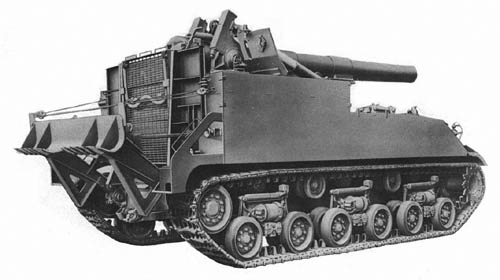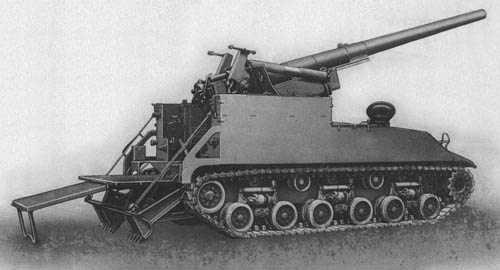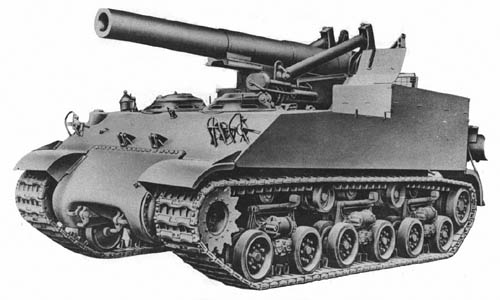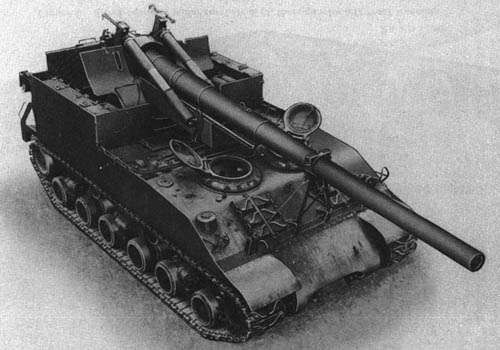The 155-mm Gun Motor Carriage M40 and 8 in. Howitzer Motor Carriage M43 were self-propelled artillery vehicles based on major components of the medium tank M4A1 with the Continental engine and HVSS suspension. The M40 Gun Motor Carriage was designed to replace the earlier M12 Gun Motor Carriage. Prototypes of the M40 were tested in WWII, but the M40 and M43 were not widely deployed until after WWII.
The following data on the M40 and M43 is taken from Technical Manual TM 9-1747.
155-mm Gun Motor Carriage M40 and 8 in. Howitzer Motor Carriage M43
DESCRIPTION:
a. The 155-mm gun motor carriage M40 and the 8-inch howitzer motor carriage M43 are identical, the model designation depending entirely upon the weapon mounted in the vehicle. When designated as gun motor carriage M40, the vehicle carries the 155-mm gun, M1 or M1A1. When designated as gun motor carriage M43, the 8-inch howitzer, M1 or M2, is used. The weapons are mounted in the rear compartment and point forward when in traveling position.
Figure 1. 8-inch howitzer motor carriage M43, three-quarter rear view.
b. This carriage is improved version of the 155-mm gun motor carriage M12, based on major components of the medium tank M4A1. The motor carriage is of the armored, full-track laying type having horizontal volute spring suspension. The hull is divided into three compartments. The drivers’ compartment is at the front, the engine compartment in the middle, and the fighting compartment at the rear. Universal-type ammunition racks for the 155-mm gun or 8-inch howitzer ammunition are installed in each vehicle. Seats are provided for a crew of eight men.
Figure 2. 155-mm gun motor carriage M40, three-quarter left rear firing position.
c. The M40 or M43 vehicle is powered by a 485-horsepower, 9-cylinder, radial gasoline engine, Ordnance Model No. R974-C4 (Continental) mounted in the center of the vehicle.
d. The vehicles are equipped with radio for intervehicle, and telephone for intravehicle communication.
Figure 3. 8-inch howitzer motor carriage M43, three-quarter left front traveling position.
e. The hull is constructed of armor plate and is divided into the fighting compartment at the rear, engine compartment in the center, and the driver’s compartment at the front. The compartments a separated by bulkheads. With the exception of several removable sections, the sided, roof and floor are welded together to form a single box-like unit. The removable sections are provided to permit access to the interior of the hull for inspection, machinery replacement and personnel. The removable parts of the hull are: spade assembly which hold the carriage against the kickback when the gun is fired; tailgate and loading ramp assembly; spotlight; drivers’ seats; oil cooler shutter assemblies; cupola hatch assemblies; spade winch and cable; exhaust and tail pipes; shell racks; and towing hooks and pintle assemblies.
Figure 4. 155-mm gun motor carriage M40, three-quarter right front view.
f. The vehicle is propelled forward and backward by two individually driven tracks. The drive sprockets at the front end of the vehicle pull the tracks from the rear and lay them down in front of the advancing road wheels. The track and suspension system consists of the tracks, which the vehicle travels on; the suspension and road wheels, which carry the load of the vehicle and travel on the tracks; the track rear idler, which is the turning point for the track and is the adjustment point for taking up slack in the track; and the support rollers, which support the upper half of the track.
DATA (M40 and M43):
GENERAL Purpose Gun carriage Type Full-track laying Crew 8 men Fighting weight: M40 83,000 lb. M43 83,000 lb. Length: M40 357 in. M43 289 in. Width, over-all 124 in. Height, overall 129 3/4 in. Ground clearance 19 1/4 in. ENGINE Manufacturer Continental Model R975–C4 Type Single-row, static-radial, air-cooled SUSPENSION Type Horizontal volute Track shoe width 18 3/4 in. Track pitch 6 in. Ground contact area of both tracks 7,544 sq. in. Number of blacks per track 87 Weight of track 4,042 lb. Ground pressure (psi) 10.2 POWER TRAIN (1-PIECE DIFFERENTIAL) Manufacturer Iowa Transmission














I just happened upon your blog. I really enjoy reading your posts.
I’ve been reading your posts for the last couple of hours, and it all has been really informative and nicely written.
Cheers. 🙂 Very good post.